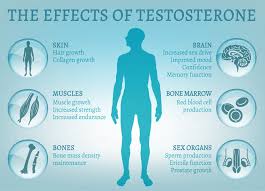Low testosterone levels, or “low T,” can affect men and women alike.
Testosterone, the primary sex hormone in men, is produced primarily in the testicles, and causes men to develop a deeper voice, larger muscles, and body hair.
Testosterone is also essential for the production of sperm.
When testosterone levels fall – called low testosterone or “low tea” – it can have a profound effect on men, both physically and psychologically.
According to Madeline Plus, normal testosterone levels in healthy men range from about 300 ng / dl (ng / dl) to 1000 ng / dl.
The general range is wide and varies with age. In older men, the lower part of the “normal” may be lower than in normal men.
Testosterone levels in the male body increase during and after puberty, then gradually decrease after the age of 30.
This gradual decrease in testosterone is sometimes known as andropause or male menopause.
Men with hypogonadism may also have lower testosterone levels, in which the body is unable to produce normal amounts of testosterone.
Hypogonadism is caused by a problem with the testicles or the pituitary gland, which controls the testicles.
Obesity, medical conditions such as autoimmune diseases or type 2 diabetes, or the use of drugs including alcohol or opioids can also help lower testosterone levels.
Testosterone and Women
Women also produce testosterone, although much less than men: According to Madeleine Plus, normal testosterone levels in women are 15 to 70 ng / dl.
In women, testosterone is produced in the ovaries and adrenal glands.
In women as well as men, low T may be due to a variety of medical conditions and aging.
In the menopausal years, women usually experience a decrease in testosterone levels.
In women, lower extremities may be associated with decreased libido, lower energy, and depressed mood.
There is some evidence that testosterone replacement therapy can increase sexual drive and help other women with other sexual problems.
But the long-term safety of this treatment is unknown, and some experts say it may increase the risk of breast cancer, although conclusive evidence remains.
Currently, the Food and Drug Administration (FDA) has not approved the use of testosterone preparations in women.
Signs and Symptoms of Low Testosterone
Male hypogonadism may be present at birth or may develop later in life as a result of an injury or infection.
In newborns, symptoms of hypogonadism include:
Vague genitals
Female genital mutilation (genetically in male child)
Advanced male genitalia
In boys of puberty, the symptoms include:
Lack of massive muscle development
Do not deepen the sound
Lack of facial and body hair
Gradual increase in the size of the penis and testicles
The arms and legs that grow in proportion to the rest of the body
In men, symptoms of hypogonadism include:
infertility
Low sex drive
Penis (ED)
Facial or body hair becomes sparse
Breast tissue growth
As testosterone levels in the body decrease with age, men may also experience:
Fatigue
Decreased sex drive
Difficulty paying attention
Change the way you sleep
However, these symptoms are unnecessary, meaning they can be caused by a number of factors, not low testosterone.
Treatment and Medication Options for Low Testosterone
Male hypogonadism is diagnosed based on symptoms, testosterone levels, blood tests, and other lab tests as needed.
Depending on what causes low T, it is usually treated with testosterone replacement and other treatments.
In men who are obese, or who have a basic medical condition, such as diabetes that can help with low T, weight loss or managing the underlying condition often causes testosterone levels to return to normal.
In recent years, a lot of advertising dollars have been spent on promoting testosterone replacement therapy for middle-aged men with symptoms such as fatigue and low back pain.
Whether it is safe or appropriate to treat such men with testosterone, however, is a matter of controversy. Some doctors are strongly in favor of it, while others are very cautious.
